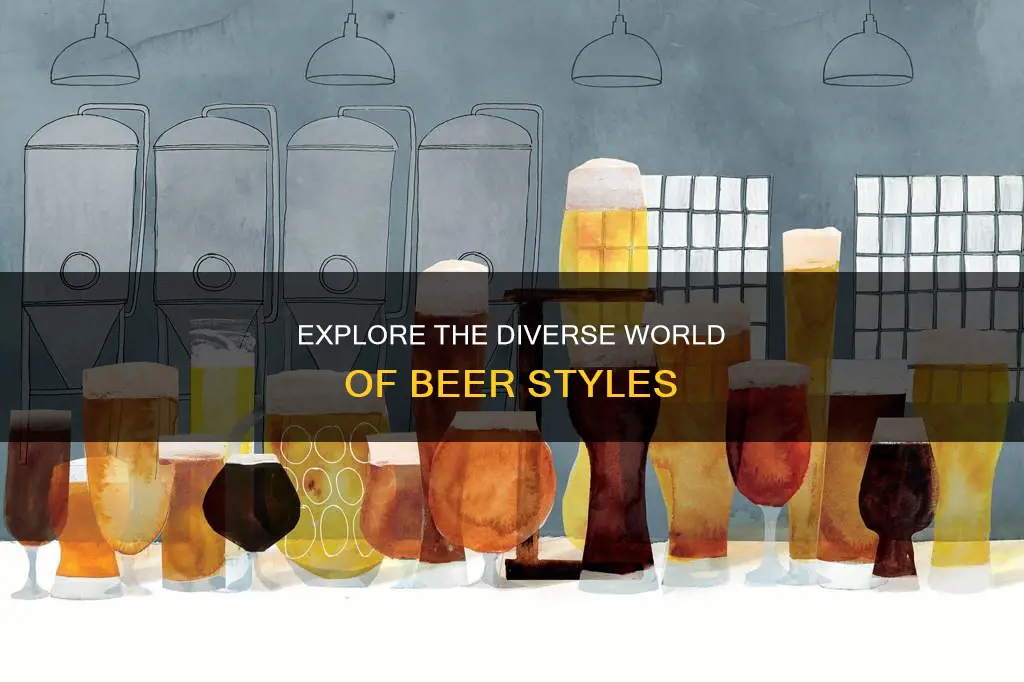
Beer is a drink with a dizzying array of options, and it can be intimidating to try to navigate the world of beer styles. However, the sheer number of styles also means that there is a beer out there for everyone.
The two main types of beer are lagers and ales, differentiated by the type of yeast and fermentation process used. Ales are created through top fermentation, where yeast ferments at warmer temperatures and settles at the top of the beer. Lagers, on the other hand, are fermented at cooler temperatures, and the yeast settles at the bottom of the beer.
From these two main types, several sub-categories emerge, including stouts, porters, IPAs, pilsners, and more. Each type of beer has distinct features like alcohol by volume (ABV), international bitterness units (IBU), colour, and taste profiles, which arise from variations in brewing styles and ingredients used.
With so many types of beer to choose from, it can be challenging to find the right one for your palate. But fear not, as there are some guidelines to help you navigate this exciting and diverse world of beer styles!
Characteristics of Beer Styles
| Characteristics | Values |
|---|---|
| Beer Type | Lager, Ale, Hybrid |
| Fermentation Process | Top-fermenting, Bottom-fermenting |
| Fermentation Temperature | Warm, Cold |
| Alcohol Tolerance | High, Low |
| Appearance | Pale, Golden, Amber, Dark, Black, Hazy |
| Flavor | Sweet, Bitter, Malty, Roasted, Fruity, Spicy, Sour, Hoppy, Crisp, Dry |
| Body | Light, Medium, Full |
| Carbonation | High, Low |
| Country of Origin | Germany, Czech Republic, Belgium, UK, US, Ireland |
What You'll Learn

Lager, Ale and Hybrid
Beer is broadly categorised into two types: lagers and ales. The two types differ in the type of yeast used and the fermentation process. Ales are made with top-fermenting yeast that ferments at warmer temperatures (60˚–70˚F) and settles at the top of the beer. Lagers, on the other hand, are made with bottom-fermenting yeast that ferments at cooler temperatures (35˚–50˚F) and settles at the bottom of the beer. Lagers are also fermented for longer periods than ales.
Ales are the oldest style of beer, dating back to antiquity. They are characterised by a warm-temperature fermentation process that lasts a relatively short period. Top-fermenting yeasts are introduced during the brewing process, which ferments on top of the brew.
Lagers, on the other hand, are a newer style of beer. They are fermented at a low temperature for a long time and rely on bottom-fermenting yeasts, which sink to the bottom of the fermenting tank.
Some beers can be classified as hybrids, containing characteristics of both lagers and ales. Hybrid beers do not conform to the conventional classification of beer as either an ale or a lager. Instead, they borrow brewing techniques from both types of beer. For instance, a beer fermented with ale yeast may be held at cooler temperatures typically used for lagers, or a lager yeast beer may be brewed as quickly and warm as an ale. This technique imparts the characteristics of both beer categories, creating unique styles that are not easily classified.
Examples of hybrid beers include Kölsch, altbier, steam beer, and cream ale. Kölsch is a German beer style made in and around the city of Cologne. It is a pale-coloured beer with a delicate flavour profile. The beer is fermented with ale yeast and then held at cold temperatures, a practice commonly associated with lagers. Altbier, on the other hand, is a style brewed in Düsseldorf, Germany. It is fermented warm with ale yeast and then aged in cold temperatures like a lager. Steam beer, also known as California Common, originated in San Francisco during the California Gold Rush. It is fermented with lager yeast but at temperatures typically used for ale yeast. Cream ale is another example of a hybrid beer. It is a genuine American-made beer that is mild, light-bodied, and pale golden in colour. Cream ale can be brewed with either lager or ale yeast.
Stout vs Porter: Unveiling Beer's Dark Secrets
You may want to see also

Pilsner
The first Pilsner was brewed in the town of Plzen (or Pilsen) in Bohemia (now the Czech Republic) in 1842. The story goes that the local brewers, fed up with their ale spoiling due to wild yeasts or bacteria, decided to take drastic action. They sent architect Martin Stelzer to study breweries in Munich and other parts of Bavaria, and he returned with plans to build an ideal brewery. The local brewers also teamed up with a Bavarian brewer, Josef Groll, who taught them the German lagering method.
Groll used light barley that was only partially malted, along with generous portions of fragrant Saaz hops, to create the first Pilsner. The brewers of Plzen were also fortunate to have access to a well that supplied very soft water, which is ideal for lager brewing. The resulting beer was light, clear, and surprisingly refreshing, unlike the dark and heavy ales that were common at the time.
The Pilsner style of beer quickly became popular and inspired many adaptations, such as the German Pils and American Light. The original Pilsner brewery became known as Pilsner Urquell, and the brand name was adopted by the new style. Pilsner Urquell still brews Pilsner to this day, using the same traditional methods and ingredients sourced from the Czech Republic.
Explore the Difference Between Ales and Lagers
You may want to see also

Stout
The first known use of the word "stout" for beer is in a document dated 1677 in the Egerton Manuscripts, referring to its strength. The word "stout" initially meant "proud" or "brave", but after the 14th century, it took on the connotation of "strong". The expression "stout porter" was applied during the 18th century to strong versions of porter.
There are several types of stouts, including:
- Dry stout: A standard stout with a drier taste than English and American sweet stouts. Guinness Extra Stout is an example of a dry Irish stout.
- Milk stout: Also called sweet stout or cream stout, milk stouts contain lactose, a sugar derived from milk, which adds sweetness to the beer.
- Oatmeal stout: A stout with a proportion of oats added during the brewing process, usually a maximum of 30%.
- Imperial stout: Also known as Russian imperial stout, this is a stronger stout with a high alcohol content, usually over 9% ABV.
- Pastry stout: A stout brewed to be intentionally sweet, mimicking the flavour and sometimes the appearance of a dessert.
Pilsner vs Lager Beer: What's the Difference?
You may want to see also

Wheat Beer
Weißbier (German for "white beer") is made with at least 52% wheat to barley malt, resulting in a light-coloured beer. Belgian Witbiers, on the other hand, are often brewed with raw unmalted wheat and flavoured with coriander and orange peel.
American wheat beers, in particular, are known for their refreshing, summery style. They are typically brewed with at least 30% malted wheat and served unfiltered, resulting in a cloudy appearance. Unlike their German counterparts, American wheat beers do not usually have flavours of banana or clove.
Beer vs Lager: What's the Difference?
You may want to see also

Sour Beer
- Belgian lambics
- Flanders red ale
- German Gose
- Berliner Weisse
Explore the Difference Between Ales and Lagers in Beer
You may want to see also
Frequently asked questions
The main types of beer are lagers and ales.
The two points of differentiation between these major beer classifications are the type of yeast and fermentation process. Ales are fermented with top-fermenting yeast at warm temperatures (60˚–70˚F), and lagers are fermented with bottom-fermenting yeast at cold temperatures (35˚–50˚F).
Some examples of ales include pale ales, India pale ales (IPA), porters, stouts, and wheat and Belgian styles.
Some examples of lagers include pilsners, German helles, and American lagers.
There are many other types of beer, including hybrids, sour beers, and fruit beers.







